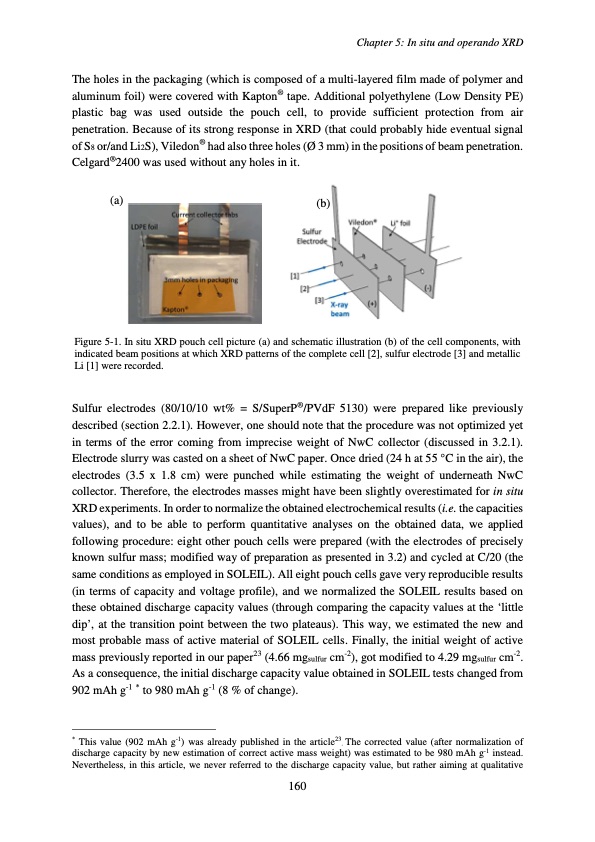
PDF Publication Title:
Text from PDF Page: 164
The holes in the packaging (which is composed of a multi-layered film made of polymer and aluminum foil) were covered with Kapton® tape. Additional polyethylene (Low Density PE) plastic bag was used outside the pouch cell, to provide sufficient protection from air penetration. Because of its strong response in XRD (that could probably hide eventual signal of S8 or/and Li2S), Viledon® had also three holes (Ø 3 mm) in the positions of beam penetration. Celgard®2400 was used without any holes in it. Chapter 5: In situ and operando XRD (a) (b) Figure 5-1. In situ XRD pouch cell picture (a) and schematic illustration (b) of the cell components, with indicated beam positions at which XRD patterns of the complete cell [2], sulfur electrode [3] and metallic Li [1] were recorded. Sulfur electrodes (80/10/10 wt% = S/SuperP®/PVdF 5130) were prepared like previously described (section 2.2.1). However, one should note that the procedure was not optimized yet in terms of the error coming from imprecise weight of NwC collector (discussed in 3.2.1). Electrode slurry was casted on a sheet of NwC paper. Once dried (24 h at 55 °C in the air), the electrodes (3.5 x 1.8 cm) were punched while estimating the weight of underneath NwC collector. Therefore, the electrodes masses might have been slightly overestimated for in situ XRD experiments. In order to normalize the obtained electrochemical results (i.e. the capacities values), and to be able to perform quantitative analyses on the obtained data, we applied following procedure: eight other pouch cells were prepared (with the electrodes of precisely known sulfur mass; modified way of preparation as presented in 3.2) and cycled at C/20 (the same conditions as employed in SOLEIL). All eight pouch cells gave very reproducible results (in terms of capacity and voltage profile), and we normalized the SOLEIL results based on these obtained discharge capacity values (through comparing the capacity values at the ‘little dip’, at the transition point between the two plateaus). This way, we estimated the new and most probable mass of active material of SOLEIL cells. Finally, the initial weight of active mass previously reported in our paper23 (4.66 mgsulfur cm-2), got modified to 4.29 mgsulfur cm-2. As a consequence, the initial discharge capacity value obtained in SOLEIL tests changed from 902 mAh g-1 * to 980 mAh g-1 (8 % of change). * This value (902 mAh g-1) was already published in the article23. The corrected value (after normalization of discharge capacity by new estimation of correct active mass weight) was estimated to be 980 mAh g-1 instead. Nevertheless, in this article, we never referred to the discharge capacity value, but rather aiming at qualitative 160PDF Image | Accumulateur Lithium Soufre

PDF Search Title:
Accumulateur Lithium SoufreOriginal File Name Searched:
WALUS_2015_archivage.pdfDIY PDF Search: Google It | Yahoo | Bing
Sulfur Deposition on Carbon Nanofibers using Supercritical CO2 Sulfur Deposition on Carbon Nanofibers using Supercritical CO2. Gamma sulfur also known as mother of pearl sulfur and nacreous sulfur... More Info
CO2 Organic Rankine Cycle Experimenter Platform The supercritical CO2 phase change system is both a heat pump and organic rankine cycle which can be used for those purposes and as a supercritical extractor for advanced subcritical and supercritical extraction technology. Uses include producing nanoparticles, precious metal CO2 extraction, lithium battery recycling, and other applications... More Info
| CONTACT TEL: 608-238-6001 Email: greg@infinityturbine.com | RSS | AMP |